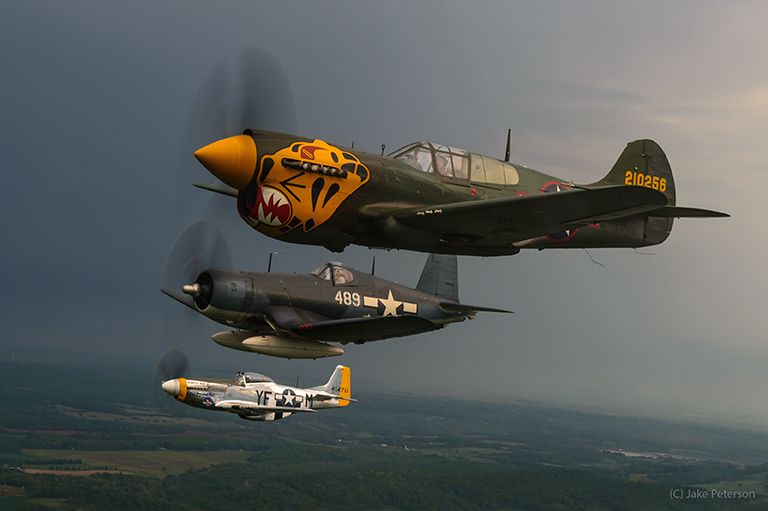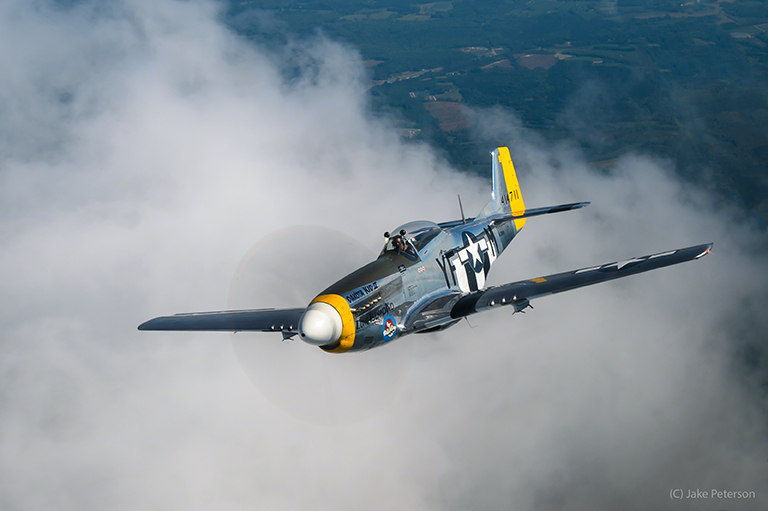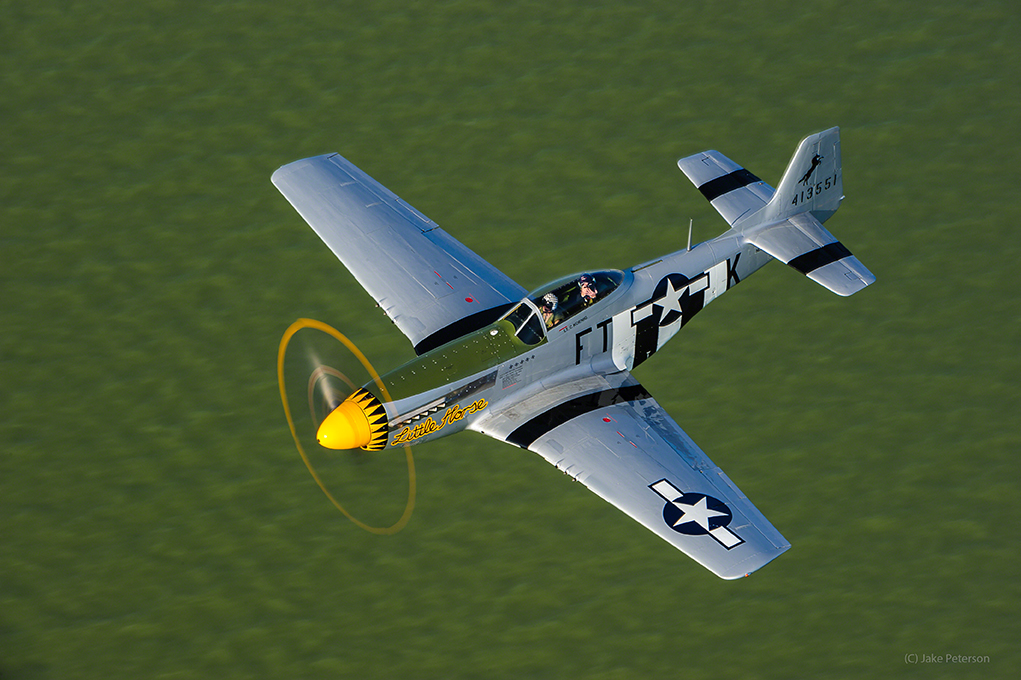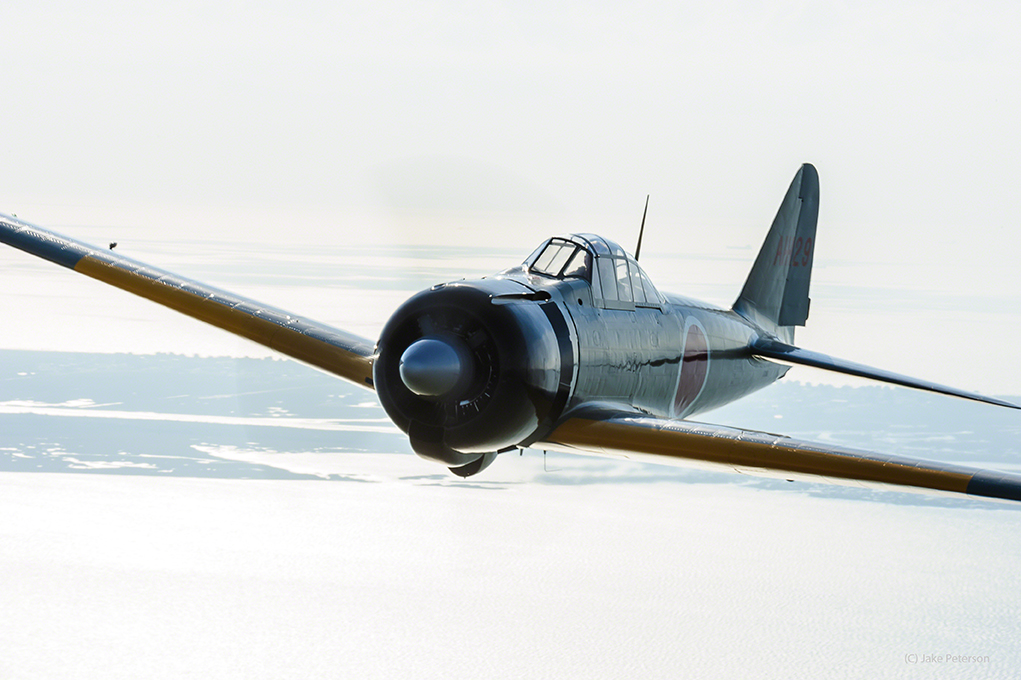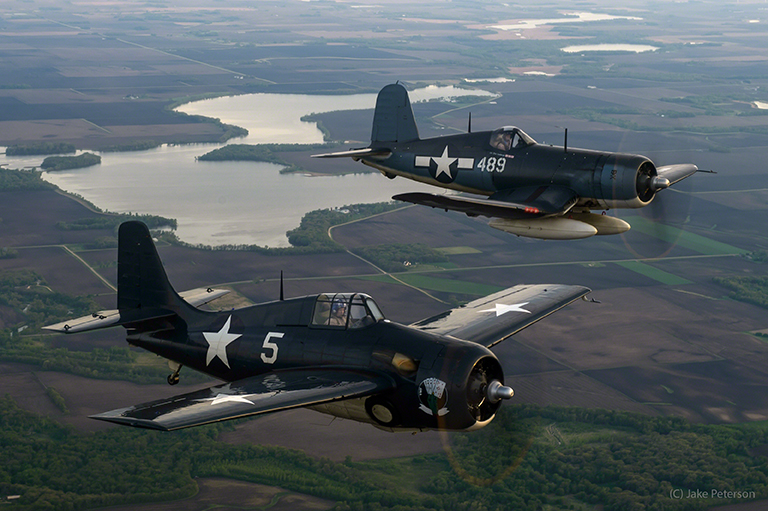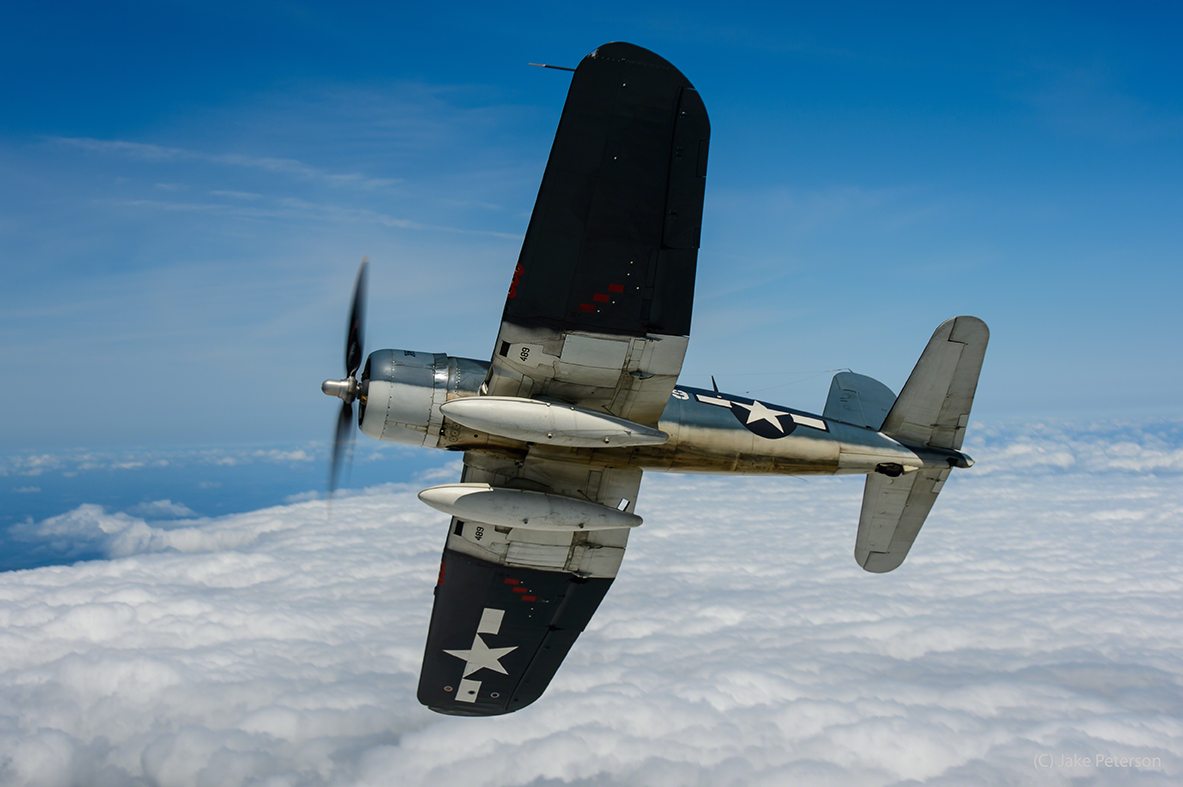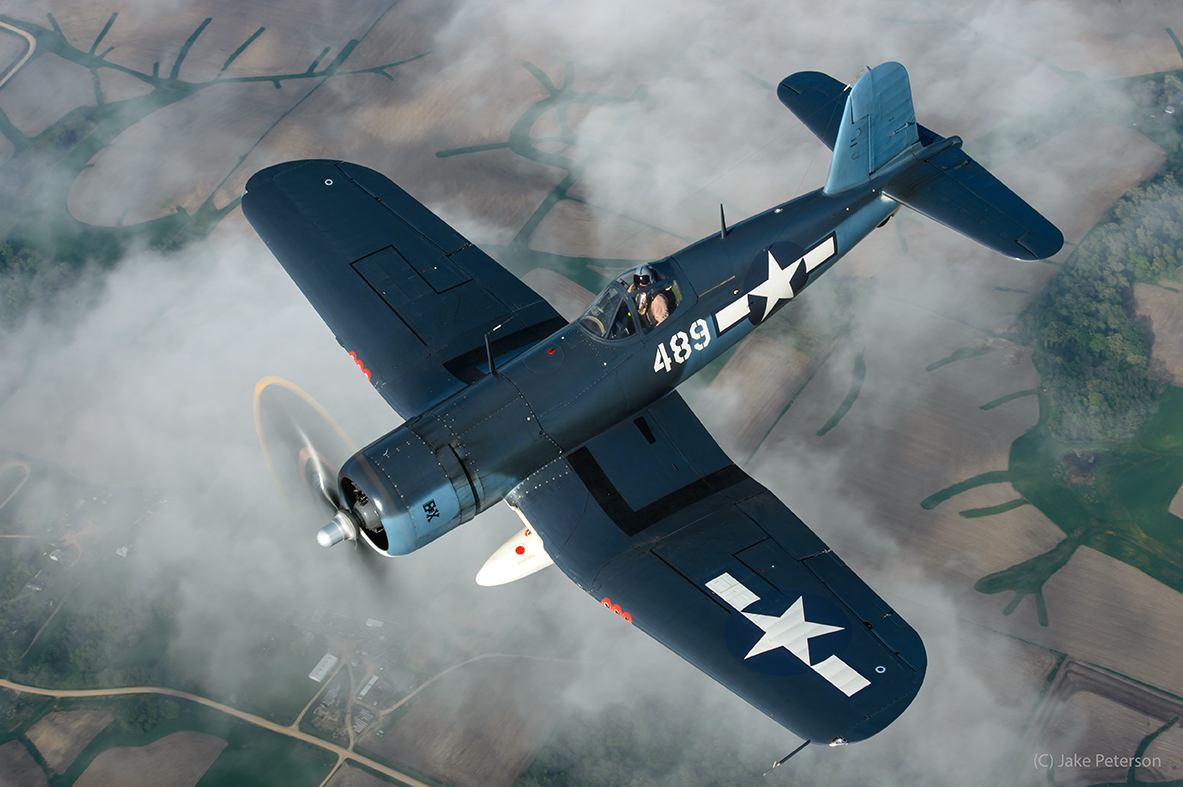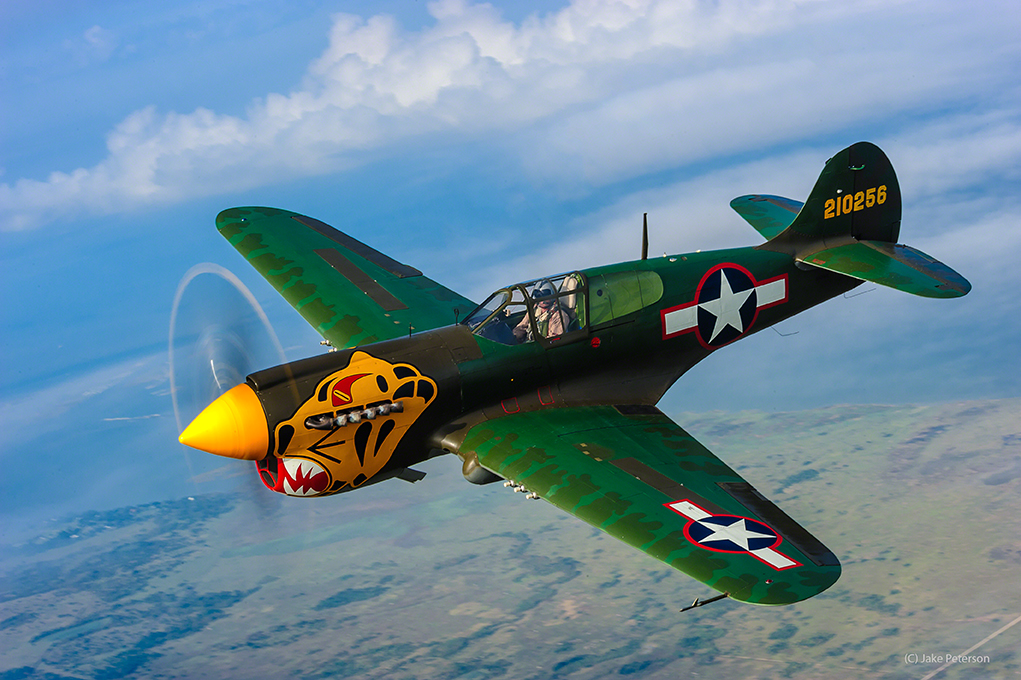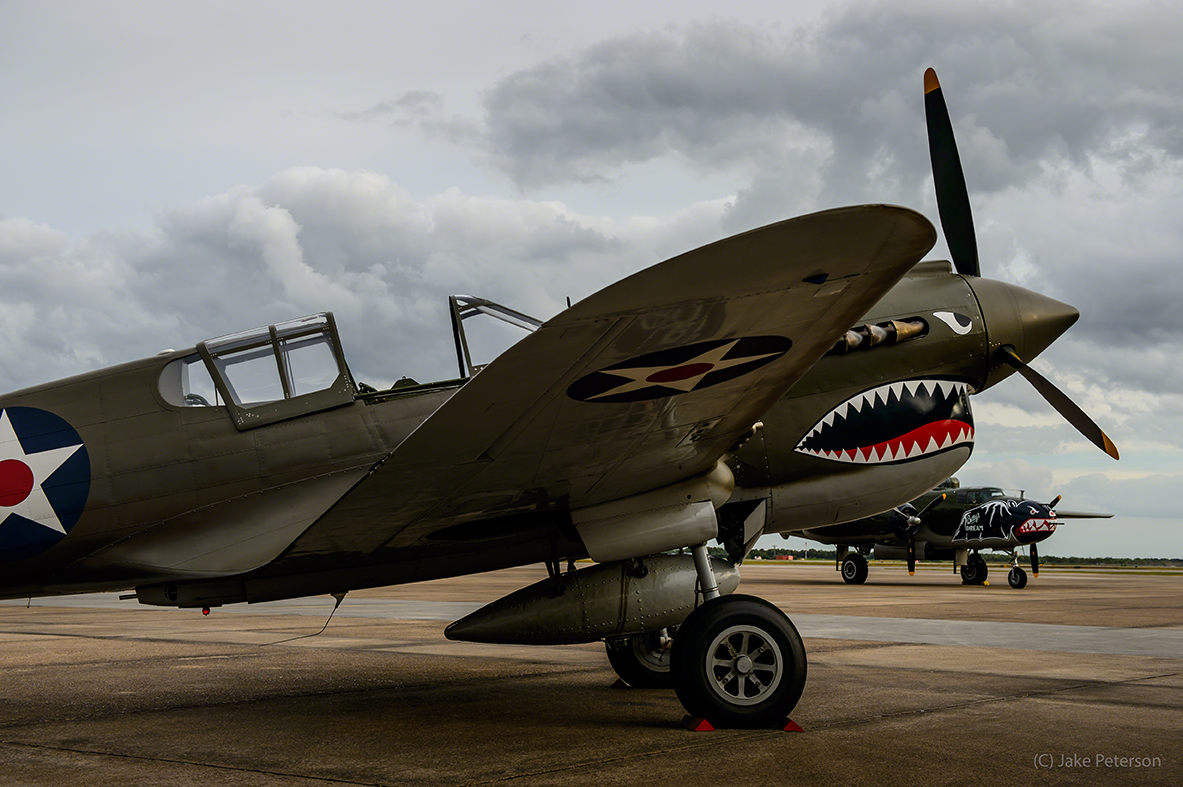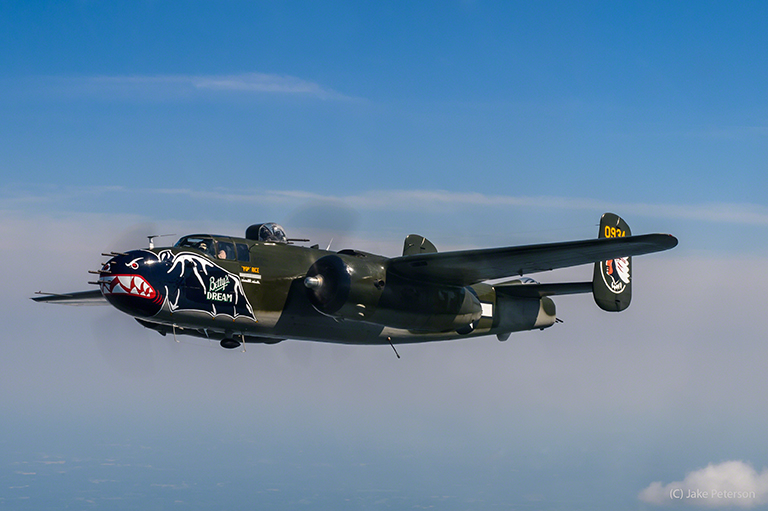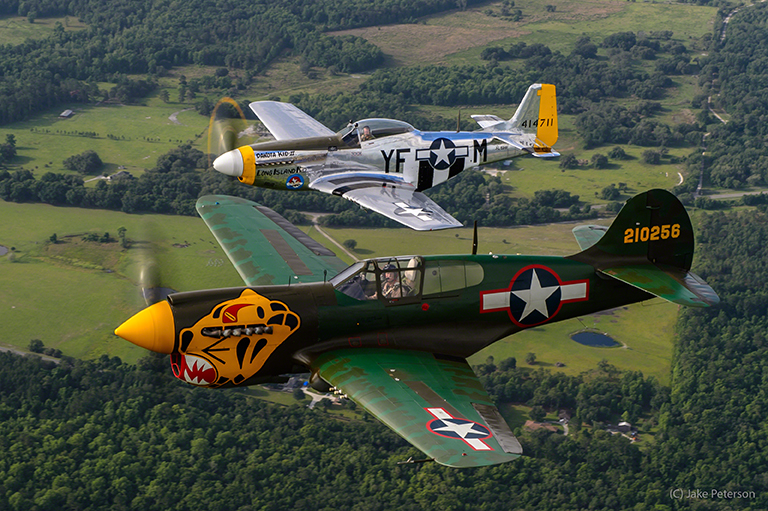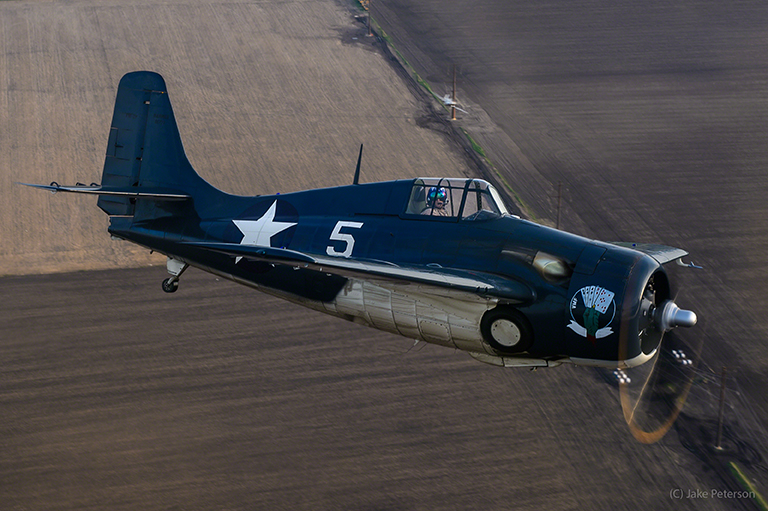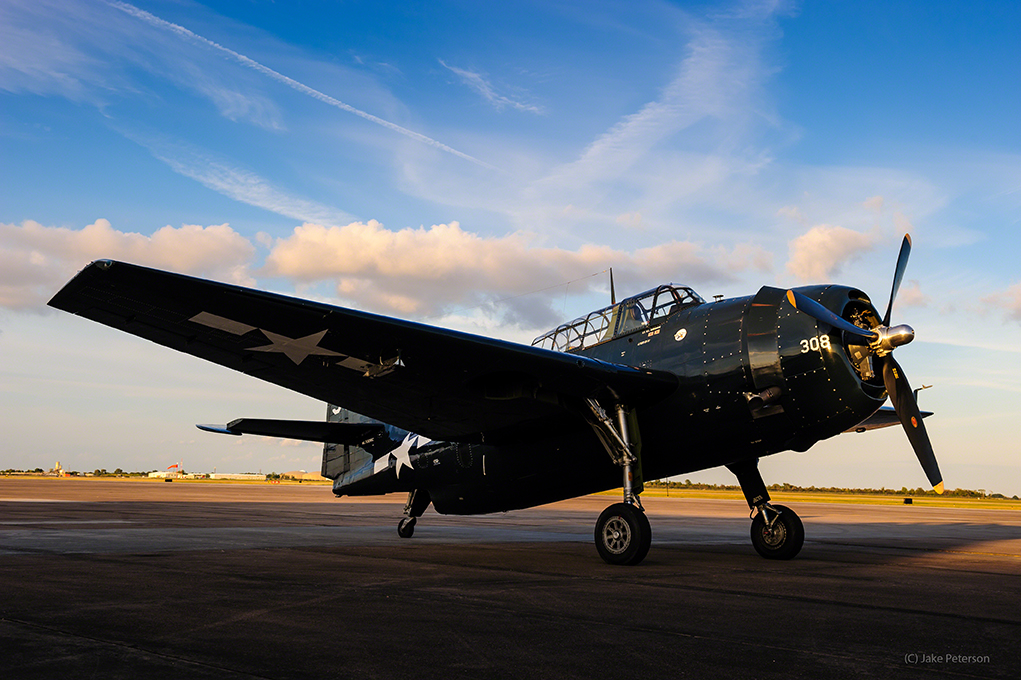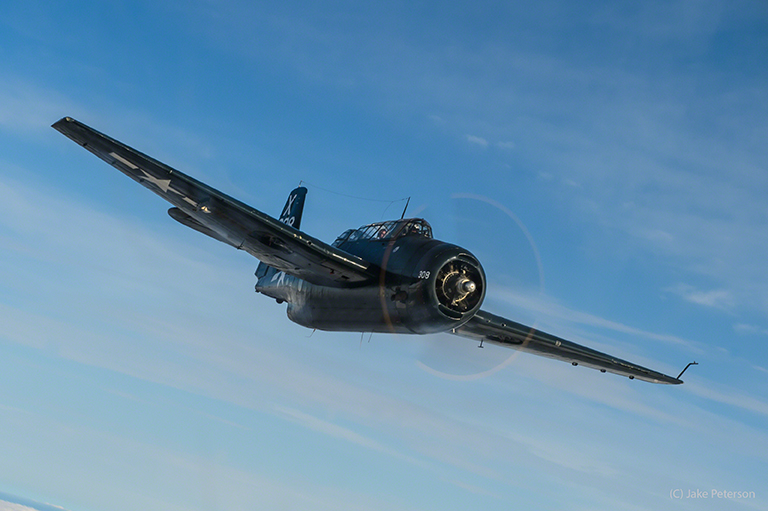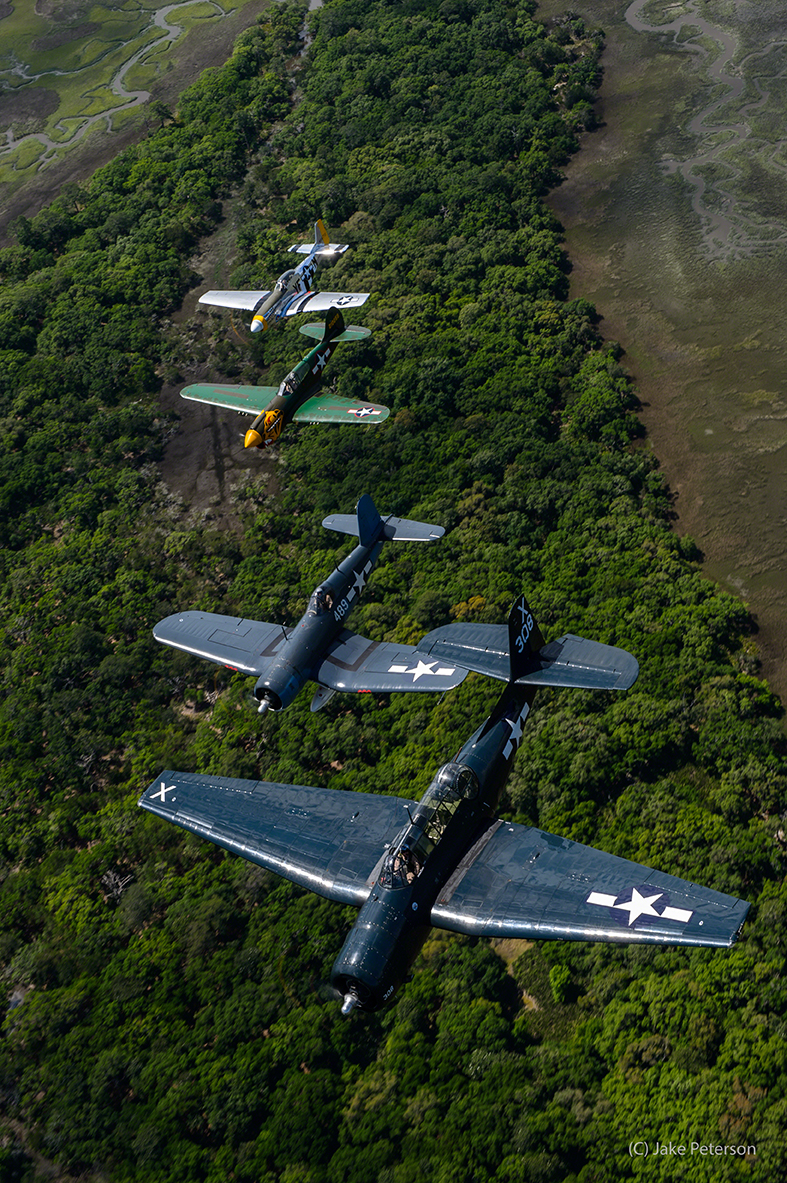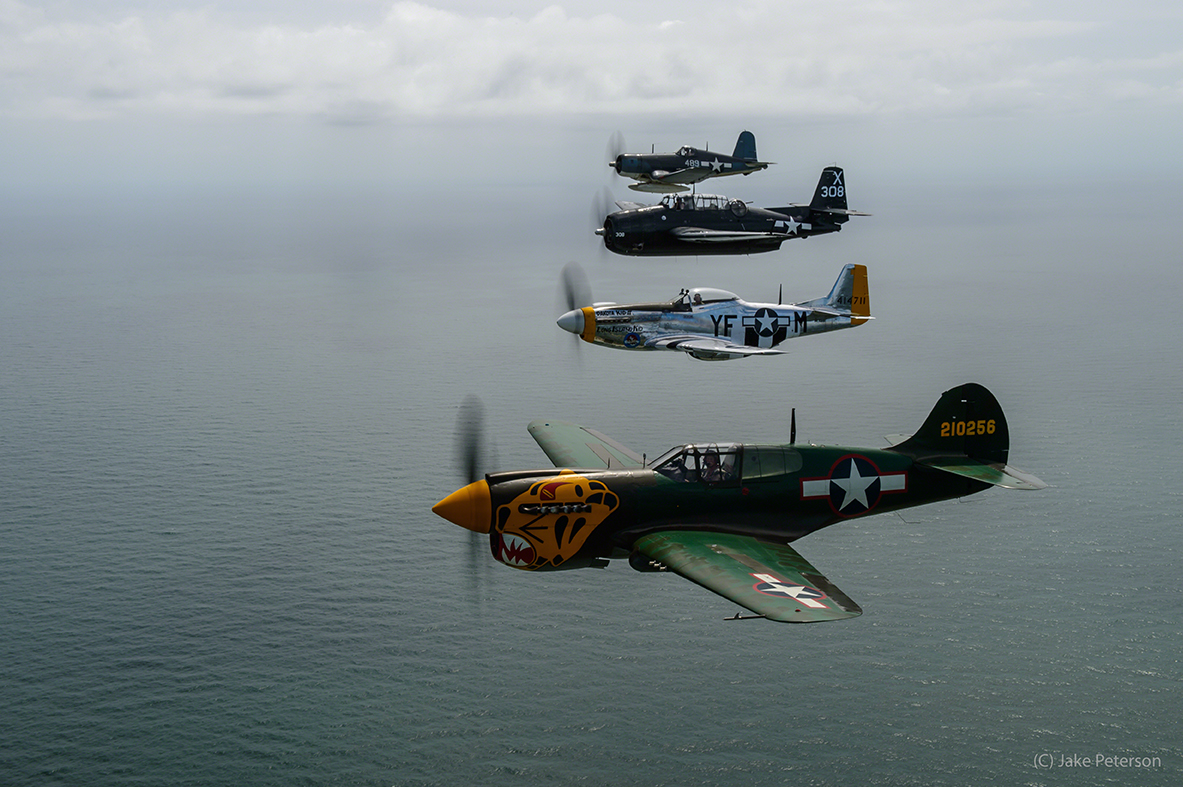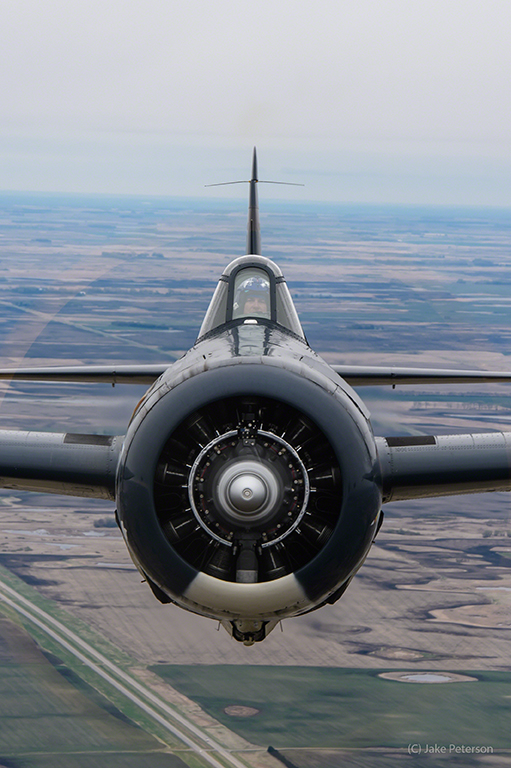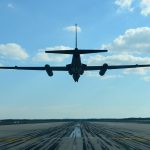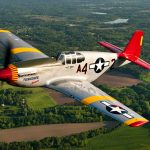The Flying Museum
Photos and words by Jake Peterson
Over the last five years, a collection of aircraft has been inspiring the young and honoring the old as one of the most magnificent traveling aviation museums in the world. The Texas Flying Legends Museum, with its fleet of twelve historic and award winning aircraft, travel across the country during the air show season bringing a unique viewing experience to all. What makes this great group run is their tireless devotion to the people and their love for flying.
It all started with the purchase of a P-51D Mustang known as Dakota Kid II from Hank Reichert, a member of the Dakota Territory Air Museum on August 27th, 2010. A month later the P-51D Little Horse joined the collection, also purchased by a private donor. Over the next five years, ten more aircraft would join the two Mustangs in the fleet; based in hangars in Houston, TX, Wiscasset, ME and Minot, ND. Each base is home to the aircraft over the course of the year. As the season’s change the planes move locations in accordance with the museum’s appearance schedule. Unlike most other museums, what makes Texas Flying Legends so special is that the planes come to the people, rather than the reverse.
In the spring, the warbirds head up to Minot, North Dakota where they undergo their annual maintenance checks and servicing after having already completed a hefty flight schedule, which for the last couple of years has included traveling to St. Barths in the Caribbean and back. Minot is home to the Dakota Territory Air Museum, which hosts the aircraft during annuals and the spring months. The Dakota Territory Air Museum also has many WWII artifacts on display, much like a more traditional museum. After completing annuals, the group heads out during the busy summer months displaying their rare warbirds to the crowds at air shows, before heading east to Wiscasset, Maine. The fleet finishes its journey back home in Texas during October for the Commemorative Air Force’s Wings over Houston Airshow. The planes remain at Houston’s Ellington Field to weather the winter months.
Currently, the fleet consists twelve beautifully restored warbirds: B-25J Mitchell Betty’s Dream, P-51D Mustang Dakota Kid II, a P-40K Warhawk, FG-1D Corsair Kathleen, P-51D Mustang Little Horse, an FM-2P Wildcat, a TBM-3E Avenger, a Harvard Mk.IV, an OY-1 Sentinel, C-53 Skytrooper The Duchess of Dakota, a P-40E Warhawk and an A6M2 Model 21 Zero.
While the museum started with a pair of Mustangs, it has grown to encompass a more “Pacific Themed” historical perspective in part due to the inclusion of one of the Allies’ leading antagonists during WWII, the Japanese Mitsubishi A6M Zero. The A6M2 Model 21 is one of just a handful of flying Zeros in the world, and the only example of this variant.
In 1937 the Imperial Japanese Navy called for a faster, better armed, carrier-operating fighter with a better rate of climb that didn’t require the use of a new engine design. Nakajima pulled out of the competition, but Mitsubishi Chief Designer Jiro Horikoshi believed he could meet the demands, but with significant tradeoffs. To save weight, he deleted armor plating and self-sealing fuel tanks from the design. He also chose a lighter, though more corrosion prone aluminum alloy for the skin. These compromises would prove vulnerabilities in later combat, as the Zero (codenamed Zeke by the Allies), could often only take a couple of hits from a .50 calibre machine gun before going down, whereas Allied aircraft like the Wildcat, Hellcat, Seafire and Corsair could withstand much more damage. Still, the Zero was one of the best single engine fighters of WWII due to its incredible range and maneuverability. If not for the nearly intact example that crash-landed on Akutan Island in the Aleutians during 1942, American engineers and tacticians may not have been able to unravel all of the planes mysteries so early in the war.
The museum’s Zero crashed on Ballale Island during the Solomon Island Campaign. Between 1965 and 1968, Canadian adventurer Bob Diemert recovered several wrecked Zeros from the Pacific islands and rebuilt two complete examples from the bunch which he sold to museums. The remaining parts went to the Calvery family, who later used them to build TFLM’s A6M2 and an additional 14,000 parts for other Zero projects by duplicating originals. As with many restorations today, much of the original airframe was not suitable for re-use in a flying aircraft, and only about five percent of the museum’s Zero is original material. The aircraft has one major modification however, with the inclusion of a Pratt & Whitney 1830-75 powerplant instead of the authentic Nakajima Sakae. The A6M2 Model 21 entered service a month after the attack on Pearl Harbor. The paint scheme for the museum’s Zero is based on photographs of a wrecked A6M-21 Zero shot down by Americans on Russell Island. Interestingly, the white ring painted around the red national insignia, or Hinomaru, means that rather than Mitsubishi, it was Nakajima which built the Zero, under license.
The Zero was the terror of the skies during the island hopping campaign early in the war, but in December of 1942, the Vought F4U Corsair entered service. Originally designed for Carrier operations, the long nose provided narrow visibility during landing procedures and initially the US Navy wouldn’t accept it for carrier operations. Instead, the US Marine Corps championed the Corsair from island bases on Guadalcanal and elsewhere. However, the Royal Navy, which accepted over 2,000 Corsairs on Lend-Lease during the war, developed a technique for landing the Corsairs more safely on carriers which opened the way for their use on American carriers too. Instead of a traditional straight-in approach, Corsairs made a flat, turning left hand approach which gave the pilot enough visibility until making the flare for landing-on. In 1944, the US Navy accepted Corsairs for carrier operations. The demand for Corsairs became so high that the US Navy contracted Goodyear (FG) and Brewster (F3A) to build them under license. The Corsair was in production from 1942 until 1953 and it wasn’t until 1979, when Honduras finally retired their last examples, that it finally went out of military service.
The Texas Flying Legends Museum FG-1D Corsair joined the US Navy on July 26th, 1945 as Bu.No.92489. While this particular aircraft never saw combat, it moved around the USA in the training role, before the Navy put it up for disposal in 1957. The aircraft then received an overhaul as part of a small batch of FG-1D’s provided to El Salvador. She stayed in El Salvador until 1979, when an American, Frank Arrufat, rescued her from a dump, and brought her back to the USA for restoration. Over a thirty year period, Arrufat slowly gathered parts for the project, and eventually he placed it with the renowned John Lane for more formal restoration. The aircraft flew again in 2010, although under new ownership, and that year Bu.No.92489 won best WWII aircraft restoration at EAA AirVenture in Oshkosh, Wisconsin. Here are some examples of why it won: unmodified instrument panel with original instruments, functional fluorescent cockpit lighting, three point canopy rearview mirrors, original WWII radio, functional pilot’s relief tube, functional tail hook system complete with wooden tail hook alignment strips, working MK. 8 gunsight, functional 16-millimeter gun camera, original engine and more!
One of the few planes to see combat in every theatre of WWII, the P-40 was a reliable trainer and fighter for every flyer. The museum’s P-40K, 42-10256 served with the Russians under Lend-Lease during WWII. It was one of two which crashed in a marsh outside of Murmansk after tangling with four German Bf-109s from JG-5. JLt II. Mikhajlov, her pilot, became disoriented during the battle which led to his crash. Salvagers discovered the two P-40K wrecks in 1991. The ended up back in the USA and Warhawks Inc. finished the restorations in 2006. Her sister ship, 42-10083, is currently flying with Fagen Fighters. The paint scheme of this P-40K is in honor of the “Aleutian Tigers,” the 343rd Fighter Group activated on September 11th, 1942 and operating out of Alaska until 1943. The Tiger design was a takeoff of the shark jaws motif used by the famed American Volunteer Group aka “The Flying Tigers” led by General Claire Chennault. The 343rd was commanded by Chennault’s son Lt. Col. John “Jack” Chennault.
One of the museum’s latest additions is their P-40E Warhawk. This P-40 is another cold weather survivor coming out of Elmendorf Field in Anchorage, Alaska. The plane rolled off of the assembly line on January 13th, 1942 as a Curtiss Model H87-A3. The military accepted her as P-40E s/n 41-5709. America was still reeling from the attack on Pearl Harbor and the Japanese were marauding up and down the Aleutian Island Chain. On June 3rd, 1942 the Japanese attacked Fort Mears and Dutch Harbor in the Aleutians. P-40s scrambled from Fort Randall but were too late to turn the Japanese back. The Japanese attacked Dutch Harbor again the next day, but this time American P-40s disrupted the force, shooting down one bomber. On June 5th, 1942 daily P-40 patrols started up in an effort to prevent surprise attacks.
On September 26th, 1942, P-40E 41-5709 departed Fort Randall with 1st Lt. Dennis Crisp at the controls as part of the two-ship, daily patrol. Upon landing in the formation, his wingman landed long and ran into 5709’s tail. Both planes were write-offs that day and ended up on the scrap heap in Cold Bay after the salvage of all useable parts. The late Dick Odgers and a team of enthusiasts started excavating the dump at Cold Bay in 1987 and recovered significant chunks of 41-5709 among other wrecks. Odgers sold on his projects over the years, and by 1990 ‘5709 was with Don Brooks in Douglas, Georgia. She was ready to fly again by August 25th, 2009, when Eliot Cross, a proven test pilot and air show performer, took 41-5709 to the skies again for the first time in 67 years. After the test flights were done, Ray Fowler, Chief Pilot and Executive Producer of the Liberty Foundation, got a turn at the stick and after several hours of flying the P-40E he convinced the board to purchase the fighter to go on tour with their B-17. They removed the rear fuel tank and installed a seat for passenger rides. Walter Bowe purchased the P-40E in 2013, who in turn sold the fighter to the Texas Flying Legends Museum in 2014, although Bowe remains a regular pilot. The P-40E wears the colors of Colonel Robert E. Scott’s aircraft while he commanded the 23rd Fighter Group in the China-Burma-India Theatre during WWII.
The largest aircraft in the Texas Flying Legends fleet is B-25J Betty’s Dream. Carl Scholl of Aero Trader once said that this is one of the finest restored B-25’s flying today. This late model B-25J was made with extra fuel tanks and eight forward firing .50 caliber machine guns for use on low level strafing runs. With a wingspan of 67ft and two Curtiss-Wright R-2600-35 engines, Betty’s Dream could also carry up to 3,000 lbs of bombs. The plane is painted in honor of Captain Charles E. ‘Pop’ Rice, Jr. of the 345th BG Bats Outa Hell, assigned to Betty’s Dream in June 1945. Co-piloted by Victor Tatelman, Betty’s Dream escorted two “Betty” Bombers carrying the Japanese peace envoy to Ie Shima on August 19th, 1945 and the return mission from the conference in Manila with General MacArthur’s staff. By the time these talks ended World War II, Betty’s Dream carried 22 mission symbols, including two silhouettes symbolizing sunken ships.
The museum’s P-51D Little Horse represents Lt Charles Koenig’s mount in the European Theatre. In 1944, while the plane was with the 354th Fighter Group, Ken Dahlberg also flew Little Horse. Dahlberg joined in May of 1944 having completed many hours in P-47 Thunderbolts. His 30 minute instruction was all that was needed in the P-51 and over the next six months he was listed 23rd out of all the fighter aces in Europe. It was Ken Dahlberg who inspired Paul Ehlen, the previous owner and restorer, to paint the Mustang in the scheme of Little Horse. After D-Day the 354th Fighter Group moved to France, Charles Koenig renamed the plane Le Petite Cheval out of respect for the French.
Each of the aircraft in the Texas Flying Legends Fleet has a unique history. The FM-2P Wildcat came out of the Howard Pardue collection. The OY-1 Sentinel flew over Iwo Jima and was restored with the matching patches of bullet holes it received. It went on to win the Heritage Trophy in Reno in 2012. The TBM-3E is a WWII vet with paperwork linking it to the sinking of two Japanese ships and having participated in the victory flyover during the Japanese Surrender Ceremony in Tokyo Bay. The TBM also participated in a ceremony honoring former President George Herbert Walker Bush in April, 2013. The former President flew TBM’s during WWII. He signed one of the Avenger’s propeller blades and watched as one of his sons and grandsons got a chance to fly in her.
The Harvard Mk.IV served with the Royal Canadian Air Force from 1952 until 1965. The movie studio, 20th Century Fox purchased the aircraft, RCAF serial 20405, in 1968 for conversion into a replica Zero for the movie Tora! Tora! Tora! however, the aircraft never received the modifications. After the movie, the aircraft ended up in storage in Mesa, Arizona. The Olsen family bought her in 1978, later selling the airframe to Bob May, a Canadian WWII enthusiast and warbird restorer, in 2005. Darin Solberg and Mark Tisler restored the plane to stock condition, and sold it to the Texas Flying Legends Museum in 2011 along with two other projects. Aircorps Aviation did the final assembly and paint, and in August 2012 it made its first post restoration flight.
The museum’s C-53 was converted into DC-3A configuration after the war. It was the star of Warbird Alley at EAA Oshkosh AirVenture 2013 with its period reenactment of painting on the D-Day invasion stripes. The aircraft’s name, The Dutchess of Dakota, came from Murray Lawler, a Linton North Dakota native, and a pilot during WWII who flew out of Great Britain. Lawler flew transport and paratroopers throughout the European Theater and took part in the D-Day invasion. He went on to receive the Air Medal with two Oak Leaf Clusters. Lawler met an English girl, Margaret, at one of the dances on base. Enchanted with English royalty and being just a plain miss, Lawler told her, “If you can’t be the Duchess of Nottingham you’ll have to be the Duchess of Dakota.”
The museum’s aircraft may be eye candy for the aviation enthusiast, but it is the mechanics and museum staff, and yes the pilots, with their tireless devotion to the planes that keep them in the sky. Most of the pilots have regular jobs and come from all around the country to fly these rare birds for the public, not for fame or recognition, but because they love to fly. The museum is constantly trying to find new ways to reach the younger audiences to inspire them with an interest in aviation and history. At every stop the warbirds make, people line up from all over to see them. I wouldn’t have believed it until I saw it myself when flying back across the country from the Arsenal of Democracy Flyover in DC this past May. At each field we stopped, every building emptied-out with people was outside looking at the planes and talking to the pilots. The folks at the airports who were listening on the radios and heard our approach would call their friends and tell them that the fleet was coming. Veterans showed up just to see the planes and talk to the pilots. In many instances, the Texas Flying Legends Museum staff called ahead of their arrival to allow veterans time to get a chance to see ‘their’ warbirds again. In 2013, at the Wings Over Houston Airshow, the museum bused in two dozen veterans for a special gathering within their hangar at Ellington Field. For some of these vets, seeing these warplanes brought back powerful memories of the likes most of us could never understand.
Over the years the museum and crew have brought something unique to every venue they go to. In 2012, at the 70th Anniversary of the Doolittle Raid at Grimes Field in Urbana, Ohio and at Wright-Patterson Air Force Base in Dayton, a special air-to-air photo flight took place for two special guests. Brothers Herb and Walter Stachler, a P-47 pilot and a B-25 crew member, got a chance to fly in their old steeds again. Herb, who sadly passed away in 2013, flew in Dakota Kid II and Walter was at the waist gun in Betty’s Dream. They were smiling from ear-to-ear the whole time!
At EAA AirVenture Oshkosh 2013, the group did back-to-back days bringing the planes and the veterans out in Warbird Alley. Veterans like, Vic Tatelman, Herb Stachler, Bill “Tiger” Lyons, Don McKibben, Joe McPhail, David Born, and Clarence “Clancy” Hess got a chance to speak in front of hundreds of people about their experiences in the aircraft on show. They do this not for the applause, but to honor the veterans and to inspire those present of what these men did for our country.
On May 8th, 2015, after months of arduous planning, the Arsenal of Democracy Flyover took place over Washington, DC. It took enormous help and sponsorship from a number of entities, including the Texas Flying Legends Museum, Commemorative Air Force, FAA, GAMA, ICAS and NATCA to make the flyover possible but on May 8th 2015, seventy years after Germany’s official surrender, we celebrated VE Day over Washington, DC. Fifty six warbirds, flying from Culpeper and Manassas, Virginia flew along the Potomac River, past the Lincoln Memorial and then east across the National Mall, before turning southeast in front of the Capitol Building. This historic event happened because a great group of individuals got together to relive this once in a lifetime experience and honor our nation’s veterans. Over thirty thousand people showed up at the WWII Memorial to watch the Flyover, including over four hundred veterans. It is this dedication to the people that pushes the Texas Flying Legends Museum to aspire for greater things.
My thanks go out to Warren Pietsch, Doug Rozendaal, Casey Odegaard, Alan Miller, Sam Graves, Bernie Vasquez, Mike Schiffer, Walter Bowe, Bruce Eames and Ed Bosarge for keeping the planes flying and our aviation history alive.
WarbirdsNews wishes to thank Jake Peterson for contributing this article, and for his marvelous images.







